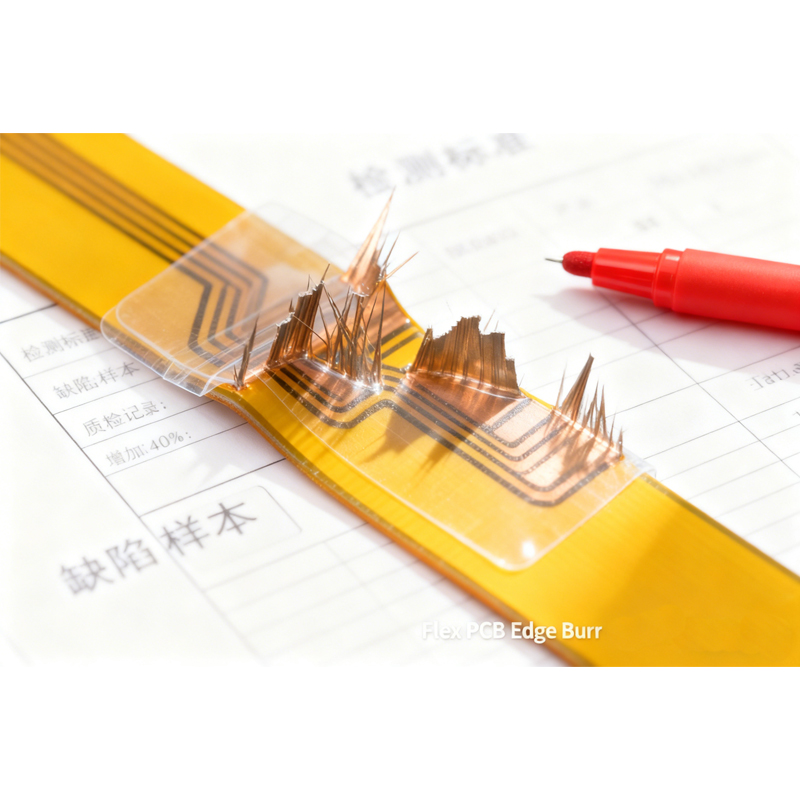Date: 2025-11-18
Let's talk about one of the most frustrating things that can happen when making flexible circuit boards - burrs. We see these pesky imperfections all the time, and if you're not working with the right manufacturer, you might be seeing them too.
So what are we dealing with here?
Picture this: you're cutting paper with dull scissors. Instead of a clean edge, you get those ragged, fuzzy bits hanging off the sides. That's exactly what burrs are like on flexible circuits - tiny, sharp bits of leftover copper or base material that stick out from the edges, holes, or circuit traces after manufacturing.
You'll find these troublemakers in all the worst places:
On the board edges after cutting
Inside drilled holes
Along the copper circuit lines
Around V-cut grooves
Near solder pads
And they come in two main types:
Metal burrs (usually copper) - sharp and conductive, perfect for causing short circuits
Plastic burrs (from the base material) - softer but still mess up how your board fits
Why do these things keep happening?
Mostly it comes down to manufacturing processes that aren't quite right. Dull cutting blades, worn-out drill bits, etching that doesn't work properly, or wrong pressure settings during V-scoring - any of these can leave behind these unwanted "gifts."
Why should you care about something so small?
Here's where it gets real:
That tiny metal burr you can barely see? It can punch through insulation and short out adjacent circuits. We've seen this cause everything from smartwatches freezing to automotive sensors giving false readings.
During assembly, those sharp edges can scratch your expensive components. They can prevent your board from laying flat, cause connection issues, and create weak spots that crack when the board bends.
Plus, if you're in medical devices or automotive electronics, burrs will straight-up fail quality checks. These industries have zero tolerance for this stuff.
Here's how we deal with burrs in our shop:
After years in this business, we've developed what we call our "no-burr guarantee" approach:
First, we prevent them at the source:
We use laser cutting instead of mechanical blades for cleaner edges
Our drill bits get replaced regularly - we don't wait for them to get dull
We've fine-tuned our etching process to wash away all the copper cleanly
Then we have cleanup processes:
Gentle chemical treatments that dissolve copper burrs without harming the board
Ultrasonic cleaning and light brushing to scrub away any remaining bits
Extra polishing on V-cut edges
And we check, check, and check again:
First boards from every batch get microscope inspection
Our optical scanners look for edge irregularities during production
For medical and automotive jobs, we microscope-check every single board
What can you do to avoid burry boards?
Ask your manufacturer pointed questions about their de-burring process. Get specific with your requirements - put "burr height under 0.03mm" right in your specs. And if you're working with thin or high-density boards, make sure they're using laser cutting.
The truth is, while burrs are a common manufacturing challenge, they're completely preventable with the right processes and attention to detail. If your current supplier is delivering boards with burrs, it might be time to ask why they can't get this basic thing right.
We've built our reputation on delivering clean, reliable flexible circuits that work right out of the box. Because in today's competitive market, you shouldn't have to worry about something as basic as burrs ruining your product.
Ready to move past burr problems? We should talk.
Capel manufacturing PCBs since 2009. Professional technology and high-precision Printed Circuit Boards involved in Medical, IOT, UAV, Aviation, Automotive, Aerospace, Industrial Control, Artificial Intelligence, Consumer Electronics etc..